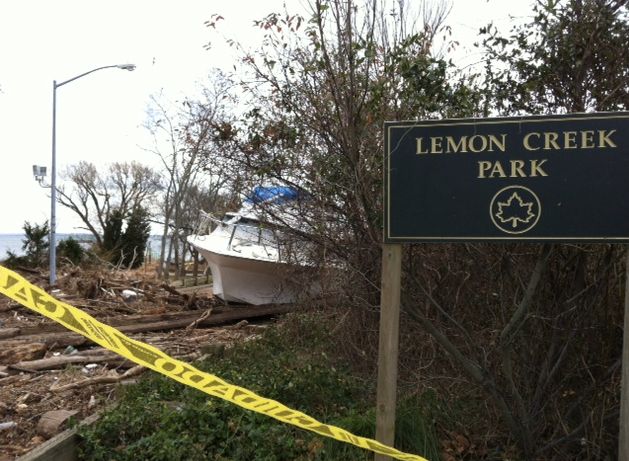
I've lived here in Staten Island since 2003. Before then, I spent my entire life across the bridge in Brooklyn and I knew that even an act as simple as crossing the Verrazano Narrows Bridge would be a huge culture shock.
My long commute is idle party chatter ("You take a boat home?") and it's almost impossible to fill the large dining room in my large house with friends who fear getting stuck on this side of the divide. Tanning jokes run rampant and I've even made a Journey jab or two myself. And I couldn't blame anyone for the ribbing. Staten Island is a different world. But a large part of that is because we feel like we are in a different world, a solitary world. And never as much as this week when Hurricane Sandy swooped into town and took 23 lives (out of 40 total in New York) with her.
As the name implies, we are a mass of land completely surrounded by water. Like Manhattan, pretty much the entire perimeter of Staten Island was in evacuation zone A; unlike Manhattan, the neighborhoods in the most vulnerable coastal areas of Staten Island are dotted with retro bungalow communities, homes built in the 1950s and 60s, that don't stand half a chance against the rage that comes along with climate change. Looking back, common sense tells us to evacuate more, prepare more, but history did not prepare us with any situation like this, and many residents felt ill prepared with the insufficient government information, which was simply "evacuate if you're within these lines."
I don't have to tell you the stories of the people we lost. By now it's likely that you've already heard about the 13-year-old girl whose family was afraid of looting and stuck behind in their coastal home, or the baby boys swept away from their mother, or the hero cop who saved his family before succumbing to rising flood waters. But I'd like to tell you about all of the neighbors in all of the neighborhoods who are working side by side to rebuild a space that federal aid left behind.
Staten Island is a small community. In size, we're number four of all the boroughs of New York City, behind only Manhattan, and we're number five in population. We're a borough that's largely blue collar: many police men and women, FDNY and city and sanitation workers call the island home. It's often noted that we're largely registered Republicans. We're filled to the brim with families, there are 31 intermediate and high schools here alone, and many people rely on cars to get to such basic places as the supermarket or post office. But neighborhood demographics skew very widely from the largest population of Sri Lankans outside of Sri Lanka living in Tompkinsville, to a growing Mexican population in Tottenville, and Italian Americans in New Springville, Princes Bay and Rosebank. The ferry and MTA express buses are packed with commuters who shuffle into Manhattan to work every day, while others never go into "the city" if they don't have to. Most who live on Staten Island are native New Yorkers, adding to the culture divide from Manhattan, bustling with eager young people bussed-in from the Midwest.
News of the extent of the devastation was extremely slow to hit the news, but it was loud and clear on social networks and online forums where personal tales fell from one ear to another like dominos. South Beach, Midland Beach and Tottenville, all east shore coastal areas exposed to Raritan Bay, leading out to the Atlantic Ocean, were ravaged by Sandy. To an island that often sits in the shadow of its brethren boroughs, there was this chilling thought: If we don't fix this ourselves, no one will come for us.
So before any news outlets even began reporting on that little known place below Manhattan, our local newspaper, The Staten Island Advance, suggested a Twitter hashtag, #siopen, to crowdsource where people could find open grocery stores and live outlets. Facebook was filled with questions and connections: Where can I find formula for my baby? Are the lights on in St. George yet? Where can I donate a box full of food? Shelters and donation centers were set up at local schools like Monsignor Farrell High School and Wagner High School. The sprawling Catholic campus of Mount Loretto became the busiest center of movement for dropping off and receiving.
Without gas to get them across the island, car pooling connections were made just so that people could volunteer their time or check-in on silent relatives. The Staten Island Mall, often a community hub, was humming with chargers in every outlet. There were couples camping out on floors for wall space and warmth, and a Starbucks opened its doors to allow everyone to use their wifi network. The mall also welcomed children in costume for some indoor trick-or-treating; a population swelling with children was desperate to provide some sort of respite from storm and tragedy.
By Friday morning I personally couldn't sit still any longer. My car on one bar of gas, I navigated my way across three local bus routes, and each time I approached someone for directions or advice, they offered me a spot in their car, even when their own fuel line was running dangerously low. Whole families moved into to each others apartments. A small animal hospital began collecting donations for animals in danger during the storm. Teenagers packed the donation center at Mount Loretto, spending countless hours sorting and packing clothing and food, stopping only when the sun went down; the building hadn't had power restored yet and still hasn't as of my writing this post.
Truthfully, I've been burned by Jersey Shore similarities. There have been many times when I'm ashamed to tell people where I live. There are times when I feel that the age divide and the political divide have me stranded, and I understand why the rest of the city had abandoned this borough. But this week, when everyone was just human, I couldn't stop myself from expressing anger over being ignored, exasperation that my house had suffered a few broken shingles when others lost their lives 20 minutes away, dispair that this had happened at all, and gratitude over every single hand that had paused their own lives to lift up their neighbor.
"A few young kids with their mom walked up my block pulling a wagon loaded with hot drinks and sandwiches."
"Susan E. Wagner needs schools supplies for students who need to report to school on Monday."
"I have an out-of-town network looking to donate books to a school that may have a damaged library"
By the time news outlets realized what was happening, our bridges and crossings were open. By Saturday afternoon, volunteers from other parts of the city arrived, as did a legion of FEMA trucks, and the Red Cross, and the National Guard. Both news and recovery helicopters have spent the weekend flying over the eastern coast line. Emergency stations were doling out free gasoline, the marathon, which absolutely would divert necessary resources from the disaster zone, thank you very much Mayor Bloomberg, has been canceled and there is hope in the air.
But what still has residents exasperated is the late response. The Red Cross station parked in Charleston, while extremely helpful, is a little late. Tottenville has been cleaning itself up amazingly. And the National Guard would have been much more productive before the remains of homes were piled up onto the sidewalk awaiting sanitation trucks. "It's all being done by the volunteers!" shouts one commenter on silive.com. At a recovery station in Tottenville, a woman picked up a clipboard to begin giving direction. "I'm from here. This is my home we're cleaning." Feelings ran similarly high at an evacuation center on the south shore where one worker wiped her brow, "I'm glad for all the help, but I don't know how I feel about all of these people coming into Staten Island." There's still a division here and a lot of questions. Why are they coming now? Why didn't anyone come sooner?
The help is welcome and absolutely necessary, but we can't help but feel that the forgotten borough, was, well, forgotten once again.
Staten Island, along with the Rockaways, Breezy Point, Coney Island and others areas on the coast needed better preparation, better awareness and a quicker response. Government help was too little too late, while friends, neighbors and families went out of their way to aid one another across not just the southernmost borough, but the entire city. But as the climate changes and more storms like Sandy, and Irene before her, batter our shores, will we break down the walls of culture shock and solidarity before it's too late, or join hands again to clean up the devastating mess afterwards?
If you're able and want to help Staten Island in the aftermath of Hurricane Sandy, here are some resources:
The Richmond Valley Animal Hospital, 4915 Arthur Kill Rd. is accepting donations of pet supplies.
Baby supplies, warm coats, blankets and cleaning supplies are needed at several drop-off locations: Seaview Avenue at Father Capodanno Blvd, Mount Loretto at Hylan Blvd. and Cunningham Rd, and Susan E. Wagner High School at 1200 Manor Rd.
On the ground, volunteers are using the Twitter hashtag #helpsi to coordinate in difficult to navigate areas.
There is a FEMA Recovery Center at Miller Field, New Dorp Lane off Hylan Blvd.
For updated information on volunteering opportunities, please see this crowdsourced map or this website with up-to-date recovery efforts.
The Carl V. Bini Memorial Fund, in honor of Firefighter Carl V. Bini a member of the FDNY tragically taken during 9/11, has created a Sandy relief fund for Staten Island residents affected by Hurricane Sandy.
